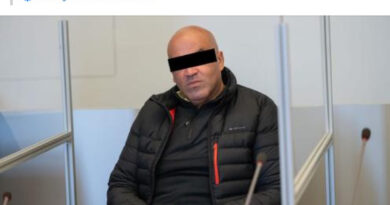Roman Emperor Nero’s Lighthouse To Be Rebuilt

Picture shows the 26.5-metre high lighthouse, which was built by Emperor Nero in the ancient city of Patara in 60 AD, and was destroyed by a tsunami in 1481. (Newsflash)
Archaeologists have used artificial intelligence to identify where all the stones go in order to reconstruct an ancient lighthouse originally built on the orders of Roman Emperor Nero.
The ancient lighthouse was destroyed by a mediaeval tsunami but most of the stones remain scattered at the scene and the team have now used artificial intelligence to work out which pieces of the giant puzzle belong where.
The knowledge of which pieces connect to which others has meant that the ancient lighthouse on the Turkish Riviera can now be rebuilt. The team said that 80 percent of the rebuilt structure will be original stone put back where it was previously before the lighthouse was destroyed.
The new stones that will be added make up the other 20 percent which is necessary to replace stones that were broken or damaged. The 26.5-metre (86.9-foot) high building was built on the orders of Emperor Nero in the ancient city of Patara in 60 AD, and was destroyed by the tsunami in 1481.
The ancient structure will now be rebuilt using mostly the original stones. Patara was a successful marine and trade city on the coast of Lycia in the modern Turkish province of Antalya which dates back to the 8th century BC.
It is also known as the birthplace of St. Nicholas (Father Christmas) in 270 AD, who lived in the nearby town of Myra (Demre). Patara Lighthouse, possibly the oldest lighthouse in the world, was built in 60 AD on order of Emperor Nero.
The script on the lighthouse says: “I, Emperor Nero, ordered this lighthouse to be built for the sake of my sailors.” On the lighthouse, there is also another inscription in gold letters addressing the Patara Assembly and the governor Sextus Marcius: “Thank you for ruling the Lycian people fairly for eight years without bribery and for decorating our city with beautiful buildings.”
There are 2,500 original stones from the lighthouse that were discovered by Professor Dr Fahri Isik during excavation works in 2000 and later unearthed by Professor Dr Havva Iskan Isik when he took over the excavation. The lighthouse’s 2,500 stones were examined, X-rayed, and their exact original locations were determined with the help of a computer programme and AI technology.
During the construction of the lighthouse, which collapsed during an earthquake on Rhodes Island in 1481 that sent a tsunami across the sea, damaged stones that can not be used will be replaced. Experts think that the lighthouse, which will be rebuilt using 80 percent original stone and 20 percent new, will be a first with these percentages as there has not been a rebuilding of an ancient structure with such a high proportion of original materials.

Picture shows the 26.5-metre high lighthouse, which was built by Emperor Nero in the ancient city of Patara in 60 AD, and was destroyed by a tsunami in 1481. (Newsflash)



